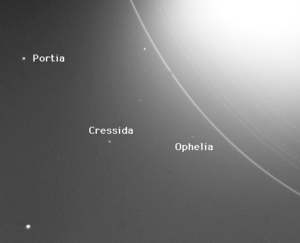Portia (moon) facts for kids
 |
|
| Discovery | |
|---|---|
| Discovered by | Stephen P. Synnott / Voyager 2 |
| Discovery date | January 3, 1986 |
| Orbital characteristics | |
| 66,097.265 ± 0.050 km | |
| Eccentricity | 0.00005 ± 0.00008 |
| 0.5131959201 ± 0.0000000093 d | |
| Inclination | 0.05908 ± 0.039° (to Uranus' equator) |
| Satellite of | Uranus |
| Physical characteristics | |
| Dimensions | 156 × 126 × 126 km |
|
Mean radius
|
70 ± 4 km |
| ~57,000 km² | |
| Volume | ~1,300,000 km³ |
| Mass | ~1.7×1018 kg |
|
Mean density
|
~1.3 g/cm³ (assumed) |
| ~0.023 m/s2 | |
| ~0.058 km/s km/s | |
| synchronous | |
| zero | |
| Albedo | 0.08 ± 0.01 |
| Temperature | ~64 K |
Portia is one of the inner moons that orbit close to the planet Uranus. It was discovered on January 3, 1986, using pictures taken by the Voyager 2 spacecraft. Scientists first called it S/1986 U 1.
This moon is named after Portia, a main character from William Shakespeare's famous play The Merchant of Venice. It is also known as Uranus XII.
Contents
Portia's Orbit Around Uranus
Portia is the second largest of Uranus's inner moons. Only Puck is bigger among them. Portia's path around Uranus is slowly getting smaller. This happens because of something called tidal forces. These are like a gentle pull from Uranus that makes Portia get closer over a very long time.
Because its orbit is shrinking, Portia will not stay there forever. Eventually, it will either break apart into a new ring around Uranus or crash into the planet itself. But don't worry, this will take millions of years!
The Portia Moon Group
Portia is the main moon in a group of moons called the Portia Group. This group includes eight other moons: Bianca, Cressida, Desdemona, Juliet, Rosalind, Cupid, Belinda, and Perdita.
All these moons travel in similar paths around Uranus. They also reflect light in a similar way, which helps scientists group them together.
What We Know About Portia
We don't know a lot about Portia because it is so far away. We know it is about 140 km across. We also know its orbit and how much light it reflects. This is called its albedo, which is about 0.08. This means it reflects only 8% of the sunlight that hits it.
When Voyager 2 took pictures, Portia looked like a stretched-out object. Its longest side points directly towards Uranus. Its surface looks grey. Later, scientists used the Hubble Space Telescope and large telescopes on Earth. They found signs of water ice on Portia's surface.
Images for kids
See also
 In Spanish: Porcia (satélite) para niños
In Spanish: Porcia (satélite) para niños


